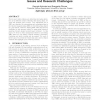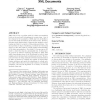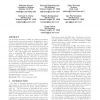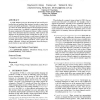EDBT
2004
ACM
14 years 11 months ago
2004
ACM
XML suffers from the major limitation of high redundancy. Even if compression can be beneficial for XML data, however, once compressed, the data can be seldom browsed and queried i...
EDBT
2004
ACM
14 years 11 months ago
2004
ACM
XML makes data flexible in representation and easily portable on the Web but it also substantially inflates data size as a consequence of using tags to describe data. Although many...
SIGMOD
2001
ACM
14 years 11 months ago
2001
ACM
SIGMOD
2002
ACM
14 years 11 months ago
2002
ACM
The emergence of the Web has increased interests in XML data. XML query languages such as XQuery and XPath use label paths to traverse the irregularly structured data. Without a s...
SIGMOD
2003
ACM
14 years 11 months ago
2003
ACM
Like HTML, many XML documents are resident on native file systems. Since XML data is irregular and verbose, the disk space and the network bandwidth are wasted. To overcome the ve...
SIGMOD
2005
ACM
14 years 11 months ago
2005
ACM
Peer-to-peer (p2p) systems are attracting increasing attention as an efficient means of sharing data among large, diverse and dynamic sets of users. The widespread use of XML as a...
KDD
2007
ACM
14 years 12 months ago
2007
ACM
XML has become a popular method of data representation both on the web and in databases in recent years. One of the reasons for the popularity of XML has been its ability to encod...
WWW
2004
ACM
15 years 3 days ago
2004
ACM
The increased importance of XML as a universal data representation format has led to several proposals for enabling the development of applications that operate on XML data. These...
WWW
2005
ACM
15 years 3 days ago
2005
ACM
The increased importance of XML as a data representation format has led to several proposals for facilitating the development of applications that operate on XML data. These propo...
WWW
2007
ACM
15 years 3 days ago
2007
ACM
As XML database sizes grow, the amount of space used for storing the data and auxiliary data structures becomes a major factor in query and update performance. This paper presents...





